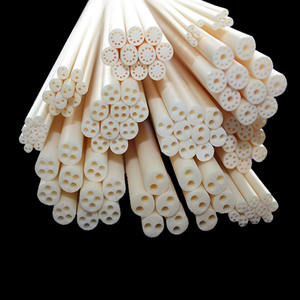Discover Premium Ceramic Products | Durability & Elegance United | Advanced Ceramics
1. Introduction
When you think of ceramics, dinner plates or coffee mugs might come to mind—but in advanced manufacturing, ceramics like silicon carbide play a far more demanding role. Among the most specialized uses is the silicon carbide crucible, a vessel engineered to withstand extreme heat and corrosive environments where ordinary materials would fail instantly. One of its most critical applications? Growing high-purity semiconductor crystals for next-generation power electronics and LEDs.

Unlike kitchenware such as silicon carbide ceramic dinner plates or baking dishes—which leverage the material’s thermal conductivity for even cooking—the industrial silicon carbide crucible is built for precision, purity, and performance under duress. Let’s dive into how this unassuming ceramic component enables breakthroughs in modern technology.
2. The Crucible’s Role in Crystal Growth
Silicon carbide crucibles are indispensable in the physical vapor transport (PVT) method used to grow bulk SiC single crystals. These crystals form the foundation of high-efficiency electric vehicle inverters, 5G RF devices, and aerospace power systems. During PVT, temperatures exceed 2,200°C in a controlled inert atmosphere, and the crucible must not only survive but also avoid contaminating the ultra-pure vapor.
Thanks to its exceptional thermal shock resistance and low thermal expansion, silicon carbide maintains structural integrity through repeated heating and cooling cycles. More importantly, it exhibits minimal reactivity with molten or vaporized silicon and carbon—unlike graphite, which can introduce impurities that degrade crystal quality.
3. Why Not Other Ceramics?

You might wonder: why not use a silicon nitride crucible instead? While silicon nitride ceramic offers excellent strength and thermal shock resistance, it begins to decompose above 1,800°C and can react with silicon vapor, releasing nitrogen that disrupts crystal lattice formation. Factories producing silicon nitride crucibles often avoid ultra-high-temperature applications for this reason.
What about boron carbide vs silicon carbide? Boron carbide is harder and lighter, but it oxidizes readily above 500°C in air and is less stable in reducing atmospheres common in crystal growth. Silicon carbide, by contrast, forms a protective silica layer that enhances oxidation resistance up to 1,600°C—and in inert environments, it performs reliably beyond 2,000°C.
4. Beyond the Crucible: Supporting High-Temp Infrastructure
The silicon carbide crucible doesn’t operate in isolation. It’s part of a larger ecosystem of high-performance components engineered for extreme conditions. These include:
- Silicon carbide ceramic tubes for furnace insulation and thermocouple protection
- Silicon carbide burner nozzles that resist erosion in combustion systems
- RBSiC silicon carbide tile blocks used as furnace linings
- Silicon carbide brick and ceramic columns for structural support in kilns
- Silicon carbide ring and disc components for sealing and rotation in vacuum systems

Even silicon carbide discs—often associated with grinding or sanding—are repurposed in industrial settings as wear-resistant seals or insulators. Similarly, silicon carbide ceramic piping and porous ceramic tubes enable controlled gas flow in high-temperature reactors without degradation.
5. The Purity Factor
Not all silicon carbide is created equal. For crystal growth, manufacturers demand high-purity silicon carbide with minimal metallic impurities (often <10 ppm). This level of purity ensures the crucible doesn’t leach contaminants like iron, aluminum, or titanium into the growing crystal—defects that could ruin semiconductor performance.
This contrasts sharply with consumer-grade items like silicon carbide ceramic baking dishes or butter dishes, which prioritize aesthetics and thermal retention over atomic-level cleanliness. In industrial contexts, even trace elements matter, making material sourcing and processing critical.
6. Future Outlook and Alternatives
As demand for wide-bandgap semiconductors surges, so does the need for reliable, scalable crystal growth. Researchers are exploring hybrid systems—such as custom silicon nitride heat shields paired with silicon carbide crucibles—to optimize thermal gradients. Yet, no alternative currently matches silicon carbide’s balance of cost, performance, and manufacturability.
Meanwhile, the high purity silicon nitride powder market continues to grow, driven by applications in bearings and cutting tools—but for crucibles in ultra-high-temp crystal synthesis, silicon carbide remains king.
7. Conclusion
From enabling electric vehicles to powering satellite communications, the humble silicon carbide crucible is a silent enabler of modern tech. Its niche application in crystal growth showcases how advanced ceramics transcend everyday uses, operating at the very edge of material science. Whether as a crucible, tube, or burner nozzle, silicon carbide proves that in extreme environments, only the toughest ceramics survive—and thrive.
Our Website founded on October 17, 2012, is a high-tech enterprise committed to the research and development, production, processing, sales and technical services of ceramic relative materials such as Why. Our products includes but not limited to Boron Carbide Ceramic Products, Boron Nitride Ceramic Products, Silicon Carbide Ceramic Products, Silicon Nitride Ceramic Products, Zirconium Dioxide Ceramic Products, etc. If you are interested, please feel free to contact us.
